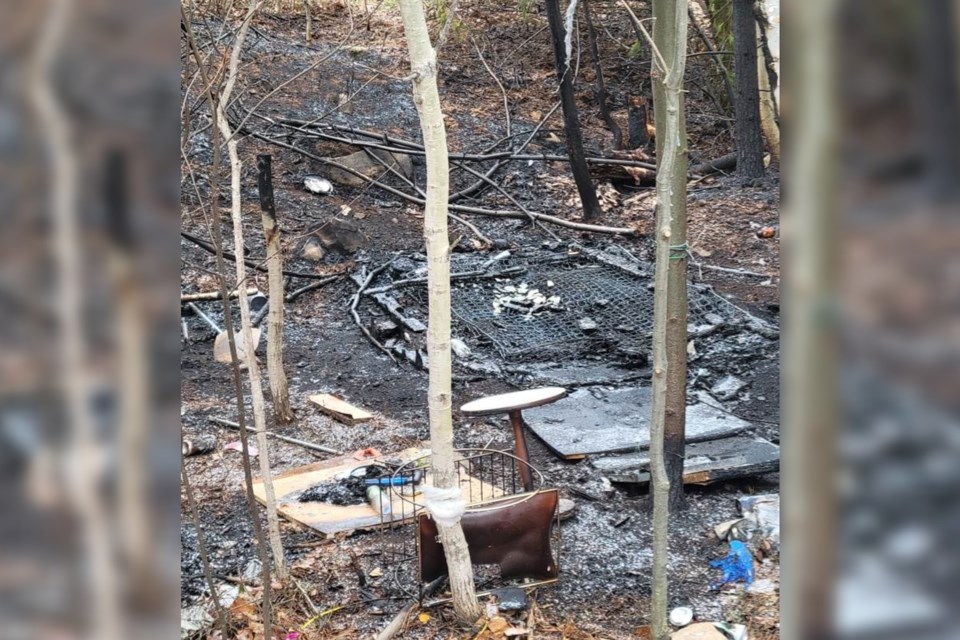Two fires ripped through homeless encampments near the downtown core this past weekend. Both were put out quickly, but one resulted in a man being transported to Health Sciences North with non-life-threatening injuries.
With the arrival of colder weather, the need for warmth could be causing some to get desperate, lighting candles or fuel heaters in order to stay warm.
Denis Constantineau, executive director of the Centre de Santé Communautaire du Grand Sudbury, told Sudbury.com the upcoming drop in temperatures will be hard on the vulnerable population of Sudbury.
“It's going to be a challenging winter, any way you cut it,” he said. “What we have available and the shelter space isn't enough to meet the need.”
In September, direct support workers provided services to 4,352 people, 66 of whom were new to them. In terms of their outreach, they have doubled the number of connections — meaning interactions with vulnerable people for anything from rides to housing support — made this year compared to 2019, the year previous to the pandemic.
The City of Greater Sudbury co-ordinated access list, or by-name list, has (as of Oct. 26) 178 people who are actively homeless (13 staying in encampments, 72 unsheltered, 51 in shelters, and 42 are provisionally accommodated or “unknown,”).
“Though the shelters aren't at full capacity now, we know that with the number of people on the street, there isn't enough capacity in the shelters. So that's a concern.”
The Homelessness Network and the city stepped in when staff shortages meant the closure of the Off the Street Shelter, and Constantineau said that is what the resources in Sudbury will continue to do, help each other help their clients.
The City of Greater Sudbury opened a warming centre at 199 Larch Street during the pandemic as many resources were at limited capacity and could not support the needs of all who required a space. At this time, the city has no plans to reopen that warming centre.
A city spokesperson confirmed that as council has not directed any plans for a 24-hour warming centre. “We will be returning to previously budgeted service level. Our current service level (back to pre-pandemic level) is the Extreme Cold Weather Alert program, administered under the Homelessness Network.”
The Extreme Cold Weather Alert program is an initiative funded by the City of Greater Sudbury to protect those who are most vulnerable to intensely cold weather conditions.
This alert puts into action a short-term emergency plan to increase community services when the temperature is predicted to be below -15 Celsius, below -20 with a wind chill, or when Environment Canada issues a storm watch or weather warning.
People on the street will be encouraged to access shelters and services. Individuals who may be at risk due to low temperatures in their homes are also eligible for these services.
Shelters currently available are Cedar Place , an emergency shelter for women aged 20 and older, or families with children, but its 22 beds are only open on a longer-term, referral basis.
The Sudbury Action Centre for Youth provides four emergency shelter beds for youth aged- 16-to-24. The Elizabeth Fry Society provides nine emergency shelter beds for women and gender-diverse individuals aged 19 and over.
The largest shelter is the CMHA run Off the Street Shelter, which has 35 beds.
During the daytime hours, the Elgin Street Mission and Blue Door Soup Kitchen offer indoor dining and drop-in services.
But Constantineau notes that while homelessness has become very front and centre in Sudbury, it is not a failure of services, but rather an increase in need, and said he worries about the effects of untrained, though well-intentioned, volunteers.
“Everyone is well-intentioned, but there's specific training for dealing with people who've lived through trauma, for dealing with critical incidents, that depth of knowledge and experience is important.”
And though there may be troubled waters ahead, Constantineau is hopeful about the response.
“The city, to their credit, has been quick to react when there have been issues that have come up. So we'll see what this winter brings,” he said.
“We have a new council coming in January. I'm anxious to see what their position is going to be and what kind of leadership we'll be getting on these issues.”
Jenny Lamothe is a reporter with Sudbury.com. She covers the diverse communities of Sudbury, especially the vulnerable or marginalized, including the Black, Indigenous, newcomer and Francophone communities, as well as 2SLGBTQ+ and issues of the downtown core.
